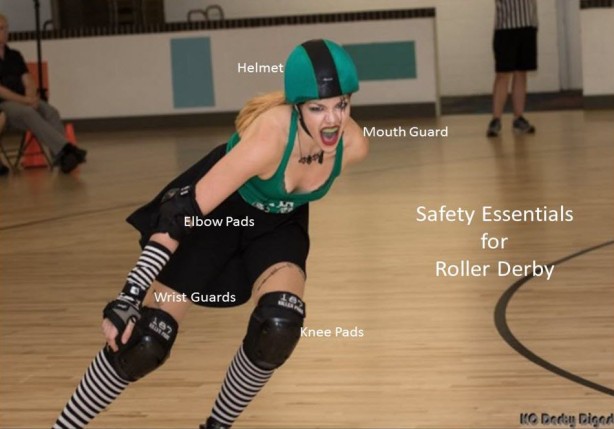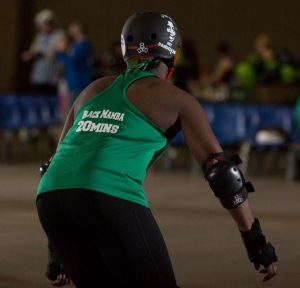For the FCRD Training Session
For the training sessions beginning in September, there will be limited quantities of used equipment available for new skaters. If you have not yet purchased your own equipment, plan to come early to practices to find equipment that properly fits you. It is recommended that you have at least your own mouth guard for all practices.B & D Skating Rink will be offering a Fresh Meat Package.
Kansas City is v. lucky to have a Derby 4 All store that you can walk into and buy equipment.
Before You Buy, Remember…
This is the only body you have, so you want to protect it as best you can! Accidents happen and sometimes even the best protective equipment can’t save you from injury, but good quality equipment will keep you on the track and in better shape than cheap stuff. You can also buy a $20 mouth guard from a sporting goods store, but a $0.99 version from Walmart will work just as well. The trick at this point is to balance cost and quality.Look around and see what the vets are wearing. Ask them about their experiences with different brands of equipment and to try things on if possible. What one person thinks is the perfect knee pad may not work for another. And because that is the case there are lots of swap / trade / for sale used sites for derby equipment. Do some research and then buy smart.
First, take stock of your body and physical condition. Are you young and relatively healthy or do you have a few off road miles of fun in your past? Do you bruise easily or does it take a Mack truck to make a mark? Do you have more than a couple of broken bones in your past? If so, you probably want to spend a little more on protective gear to start out.
Also remember that safety gear is not intended to last forever. Much of it will stretch over time, especially knee and elbow pads, so buying a size that does not fit snugly now will likely not serve you for long.
The Essentials

Photo Courtesy of KC Derby Digest
Helmet
First, the item that protects your most important asset: the helmet. You only have one head and science hasn’t figured out how to replace them yet so you need to keep yours in good shape. There are lots of different helmet styles out there, from cheap bicycle helmets to expensive hockey helmets. Don’t just assume that because it is sold as “safety equipment” it will meet your requirements for protective equipment. Skate helmets should meet the ASTM F1492 standard for multiple lower-impact “trick roller skating” use. Bike helmets are not typically sufficient as they are CPSC standard for single high-impact use. Some helmets, however, qualify for both standards. Take some time to ensure that your helmet meets the right standard.As for fit, the helmet should come down over the front of your head and the chin strap should be snug and secure. Your helmet should not be too tight or too loose. If your helmet is pushed back off your brow it may slide out of the way when you fall, allowing your forehead, nose or mouth to hit the floor and be injured. The helmet should be no further than two fingers above your brow line.
Mouth Guard
Next, your mouth guard. If you have had extensive (and expensive) dental work, check with your dentist to see what they recommend you wear. Otherwise there are a variety of products on the market. You can get some from sporting goods stores that range in price from $10 – $60 with dental insurance for you should something happen to your teeth while you are wearing their product. Walmart has inexpensive ones in their sporting goods section that work just fine for most people. (And the upside of cheap is that you can afford more than one so you can keep a spare in your skate bag just in case.) One of the most popular brands for roller derby players is SISU, which is more expensive but comfortably small and perforated to avoid excess spit buildup.No matter which mouth guard you choose, remember you have to form it to fit your mouth. Don’t expect to just take it out of the package and pop it in your mouth and have it fit comfortably.
Knee pads
Right now, if you are still trying to master crossovers you are probably thinking you want the most low profile kneepads you can find. But you would be wrong. You are going to fall on your knees. A lot. At every practice. Sometimes on purpose, sometimes by accident. Trust us, the more padding your knee pads have, the better protection they will offer you and the happier you will be after falling drills. A good rule of thumb is to pinch the padding in the center of the knee plate and not have it feel like your fingers are almost touching. That is a sign of too little padding. The more you weigh, the more important it is to have a good amount of padding to protect you when you fall.Other things to consider are size and how they go on. Some pads slide over your feet and up your leg, while others have straps that Velcro around. Most have additional straps that fasten below the knee to keep them from sliding out of place. Ask around for recommendations and try on different brands if you can.


No comments:
Post a Comment
Leave us a message and we will get back to you as soon as possible.